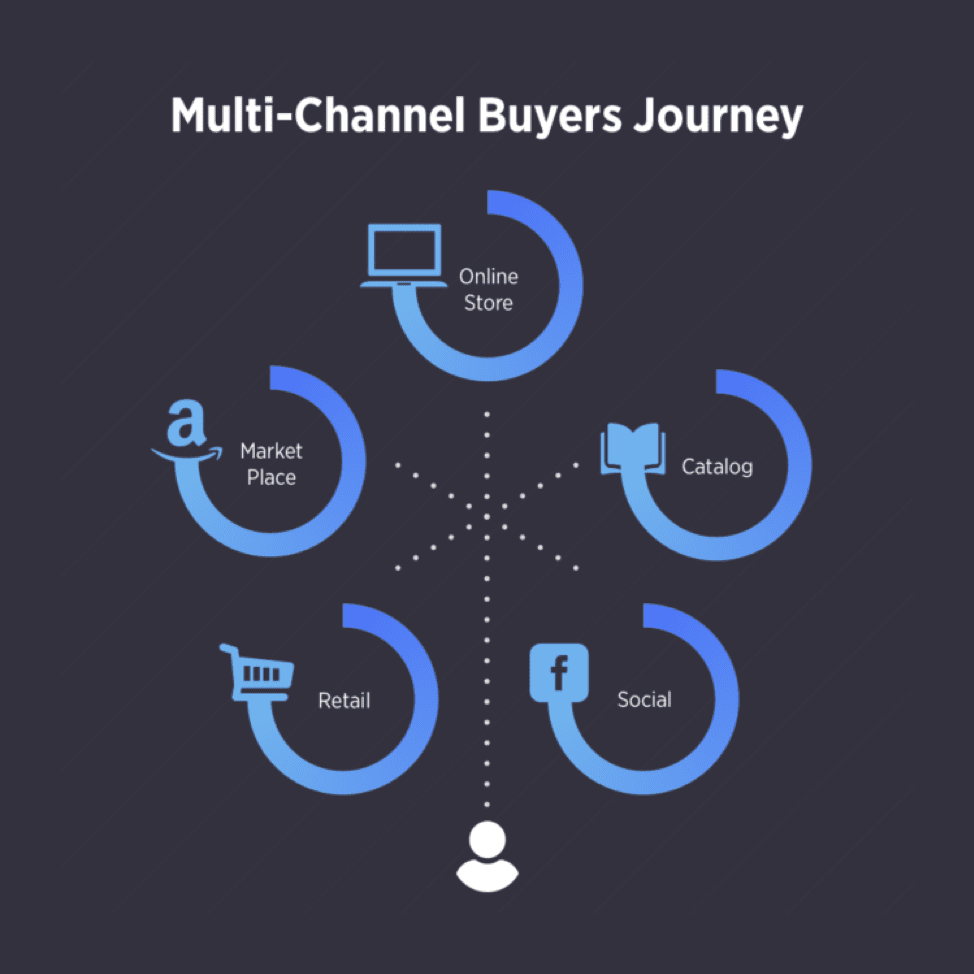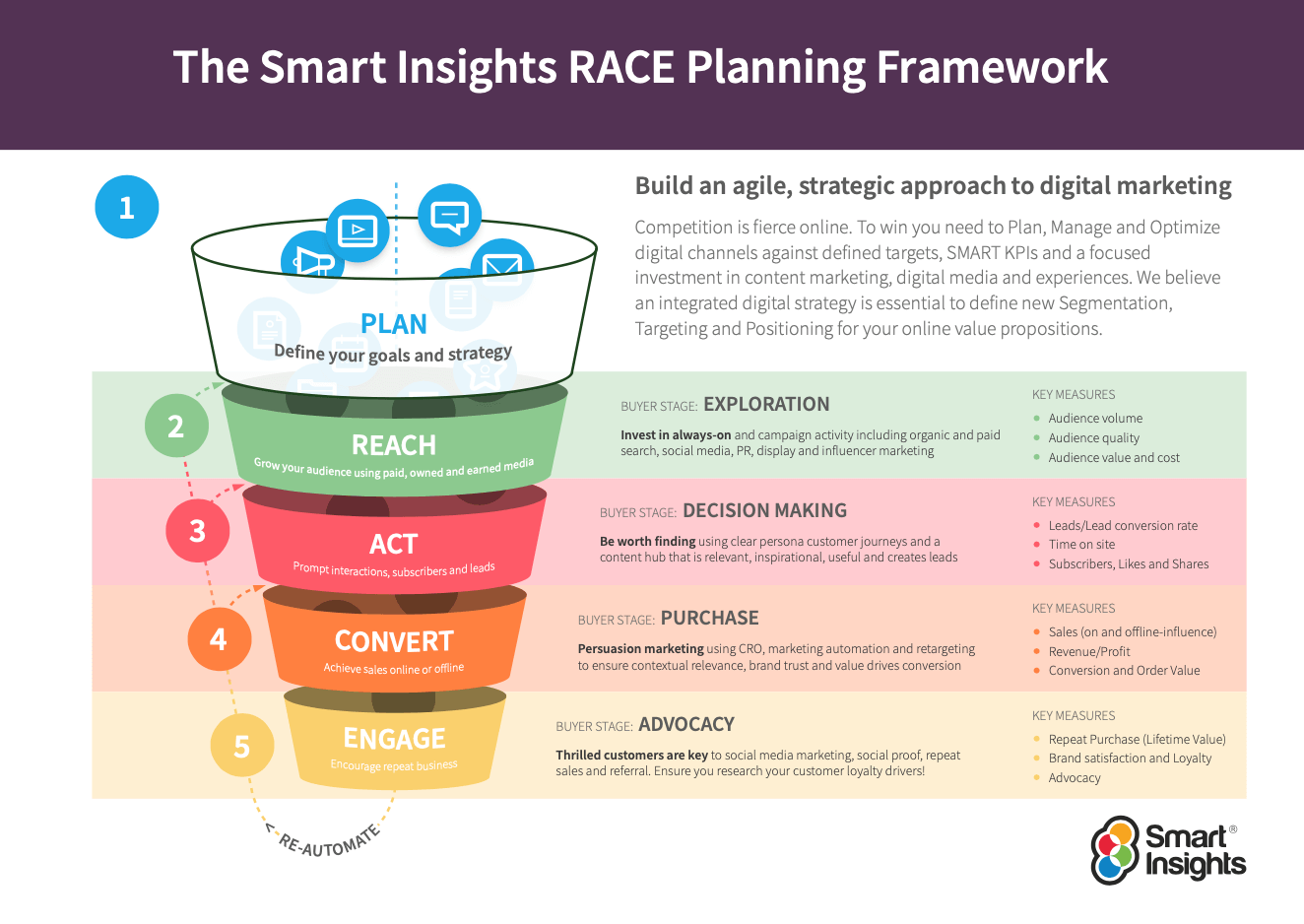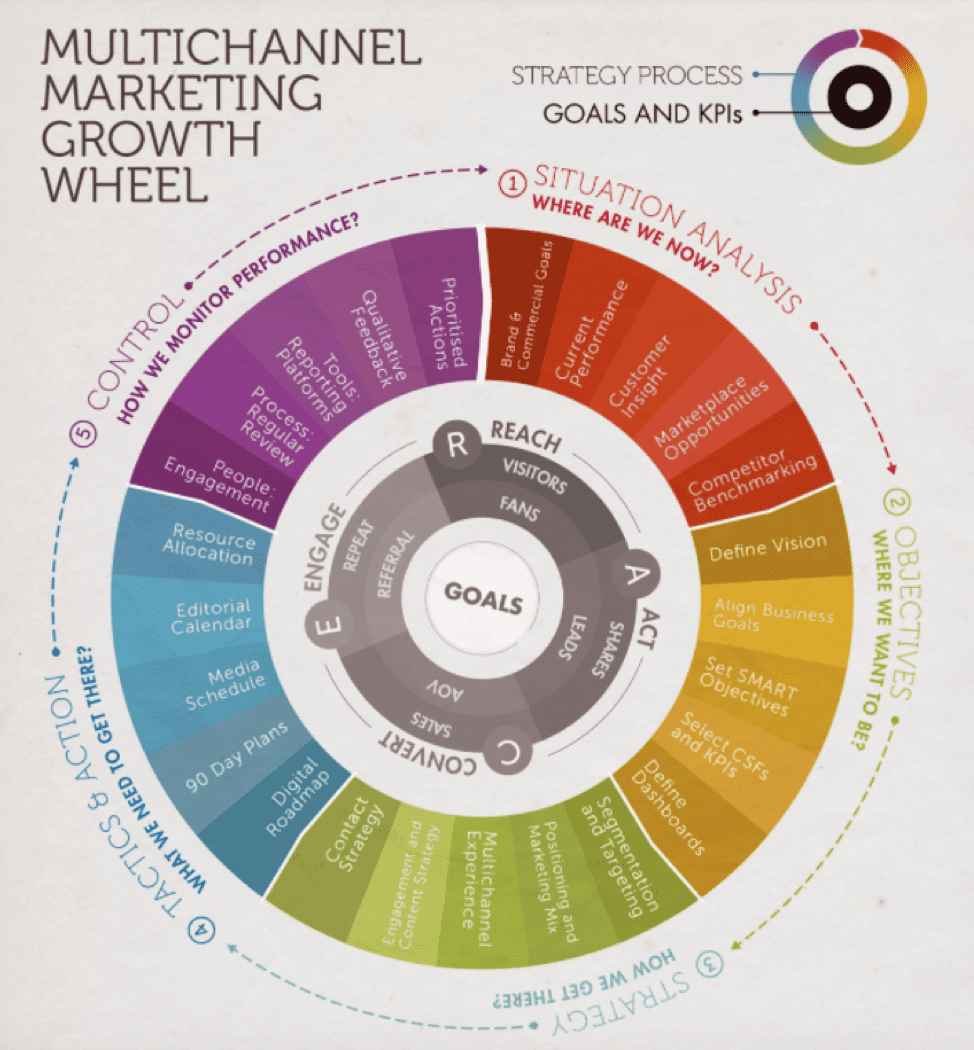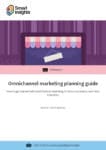E-commerce businesses cannot stay on one platform if they want to get ahead of the competition. This is where e-commerce multichannel marketing comes in
Channel loyalty doesn’t exist; buyers check different channels before they make a purchase.
Even with promos, they still compare offerings. Take Amazon prime day for example. Some 76% of shoppers plan to visit other channels before making a purchase. Around 46% of them compare prices at Walmart, 40% use Target, 39% try brand websites.
E-commerce businesses cannot stay on one platform if they want to get ahead of the competition. This is where e-commerce multichannel marketing comes in. Multichannel marketing involves promoting and selling on every channel that your customers can interact with you on.
Download our Premium Resource – Omnichannel marketing planning guide
Our omnichannel planning guide will outline the differences between omni and multichannel marketing and then help you create a strategy and roadmap for achieving your own omnichannel marketing objectives, using examples from global brands.
Access the Omnichannel marketing planning guide
When going the route of multichannel marketing, the issue isn't in choosing all the platforms that there is. It's in maintaining a competitive edge. Many brands are marketing on multiple channels; you need to stand out.
This article gives powerful tips that improve the effectiveness of your e-commerce multichannel marketing strategy.
Tip 1: Define channel focus
Multichannel doesn’t mean being everywhere. You don't have to push out on Twitter, LinkedIn, Facebook, blogs (including those not directly related to you), and so on. Before you choose any channel, define what it means for your business.
Every channel you pick should work for your business model, industry, and target audience.
Facebook has more registered users than any other social network. However, it might not be as good a fit for your business as LinkedIn or Twitter. B2Cs usually have better success on Facebook, some on Instagram, but B2Bs might not record that same success. In that case, LinkedIn may be the best choice for them.
If you're thinking of using email or mobile marketing, consider your audience. Would they want to receive text messages or emails from you?
Narrow your channels to the most strategic ones for your target audience. The first step to that is knowing who your targets are. Ask these questions:
- Where does your customer live?
- What is their education level?
- What stage are they at in their carrier?
- What is their income range?
- What age group do they fit into?
- What pain points do they have that connects to your products?
With the answers, you can brainstorm the platforms your prospects are likely to pay attention to your message on. For example, baby boomers are less likely to be on Snapchat. If you are targeting teens, direct mail marketing may not work so well.
It’s best if you don’t decide on platforms on your own, otherwise, you may end up with wrong information formed up in your head. Instead, ask people in your target group. You can do this through questionnaires, surveys, or simply by talking to them.
Platforms you can look into include:
- Paid marketing on Google or affiliate sales networks
- Social media
- Organic search engine results
- Marketplaces
- Online communities
- Blogger/influencer mentions
- Messaging apps
- Email
Note down the channels your competitors are using as well. While you can use the same channels, also look out for any platforms they are not using and which could be relevant to your industry.
Tip 2: Understand the buyer's’ journey
It takes more than one touchpoint or interaction before buyers are likely to purchase from you. If they visit your website through organic search, they may leave without converting.
Also, people hardly buy a product the first time they see it. Instead, they may search for reviews, compare your product price with that in another marketplace, ask around, etc.

[Source]
To grow and scale an e-commerce business, you need to understand the buyer's journey. There are four phases buyers will pass - awareness, consideration, decision, and post-purchase.
The awareness stage may be on social media. If interested, they go to your site, then leave. Afterward, they may consider buying and search for reviews and other information via search engines and bloggers. Then, their decision to buy takes them to either a marketplace (Amazon, Etsy) or your online store to make a purchase. Alternatively, they may choose not to purchase anything. The buyer’s journey is not one simple straight path.
In the phases, they may interact with five to seven channels. Understanding how customers interact with these touchpoints will help you plan a better experience.
Tip 3: Build a multichannel marketing plan
From your understanding of the journey that each buyer persona might encounter, you can build an e-commerce multichannel marketing plan.
An effective marketing plan includes communication techniques, content types, and the channels you will use to interact with customers. Your multi-channel marketing plan should have:
- Realistic and attainable goals
- The buyer personas and sales channels that work for them
- Detailed marketing tactics and communications for each channel across multiple devices
- Action plans to keep you on track
- KPIs and measuring tactics for them
Two frameworks that can help you with this are PR Smith's SOSTAC® Planning Framework (www.SOSTAC.org) and RACE Planning system. It’s best you use both, for which we have guides and templates available in our digital marketing planning and marketing planning toolkits. This marketing funnel is a combination of SOSTAC® for planning and RACE for implementation.

You can use this marketing wheel, structured by SOSTAC® to keep track of your strategies and KPIs.

Tip 4: Use dynamic re-marketing across all channels
Dynamic re-marketing enables you to show product ads to customers/prospects who have already visited your website. Products they have viewed on your site are marketed again to them with messages tailored for the buyer behavior and the product. This can lead to higher conversions and a lower cart abandonment rate.
In using this technique, connect your product feed - price, image, unique ID - to your ad building and serving platform. Depending on the platform you use, you can add dynamic retargeting tags to all pages of your website and social media ads. Some ad platforms identify each customer based on cookies or by associating each visitor with a unique ID to note the product they viewed.
You can also retarget to emails. Using an email marketing software, you are able to remind them of their wish list or a special discount on the product they looked at on your website.
Set up retargeting on as many platforms as you can. This is a strategy that can get you 1300% ROI.
Bonus tip - Activate your product ads for dynamic prospecting on Facebook and Google. Dynamic prospecting brings user information and your product information together to show your best product at the right time to people who want it. This is great for acquiring new customers.
Tip 5: Modify marketing messages to fit each channel
Every channel is unique. What works when it comes to email might flop on Facebook. What works on Facebook might fail on Instagram. If you go about pasting the same messages everywhere, your marketing strategy might fail.
You have to consider the expectations of audiences in each channel when crafting messages. Instead of creating and pasting the same message on every channel, tailor it to how that channel works and your prospects there.
For example, you can use YouTube to share step-by-step guides on how to use your product in a new way or interview videos. Email marketing can go on to show them product updates, cross-sell products and other customized messages. You can use Facebook to send short texts spurring them to read your blog post or give a brand update.
Some messages can go on more than one platform. Some others may need editing to conform to the channel. It’s all about promoting your product across relevant channels with a twist.
Tip 6: Use a CRM software to target prospects
E-commerce multichannel marketing is as good as the technology powering it. You can send content every day on multiple channels for as long as eternity. However, if you are not keeping up with your targets as they bounce around those channels, you may lose sales.
Rather than aimlessly drowning each channel with content, purposefully target individuals that come in contact with your product. You can do this with Customer Relationship Management (CRM) software.
CRMs allow you to keep track of all the interactions a customer has with your brand. You can pick one that connects with all the channels you are using to ensure no interaction is unrecorded. When a customer responds on a channel, the CRM immediately creates a user profile. That profile is continually updated with every interaction.
With this, you can understand how a customer is moving through your channels and pinpoint trigger events that could signify what that person is after. You can also notice conversion paths that work better with that profile. With those paths, you'd understand when, where and how each customer prefers to be reached. Using that information, optimize your channels and launch targeted campaigns to improve sales conversion.
CRMs also help you identify long-term loyal customers. You can give rewards to them. They will, in turn, attract more customers through word-of-mouth.
Tip 7: Leverage influencer multi-channel marketing
Almost every e-commerce brand is using multichannel marketing strategies. As a result, customers are tired of interruptions from ads.
They can’t watch a video in peace on YouTube or Facebook; they can’t read blog posts without interruptions from pop-ups. That is the reason for ad-blockers. For the ads they can’t block, they skip them. If your prospects pay attention to your content, it’s either because you seem very interesting or they are looking for the product you sell.
Influencer marketing is the warmer deal. Using a face that is known, but not typically associated with your brand prompts more people to check out what you are about.
There are influencers on most channels for B2Cs, for example, YouTube stars, Instagram models, bloggers and Facebook experts. Team up with a few of them to market your brand on your channels. If you are selling Yoga leggings, you can team up with famous yoga teachers. If it’s an energy or protein product, fitness models are a good one.
You can have them take over a social media channel for a day or a few minutes/hours. Another strategy is recording a video of them using your product/service or a discussion with you/a key person. They could also feature in a product advert or write a review of your product.
B2B influencer marketing can take a long time before you record massive results. They are effective nonetheless. That's because a majority of B2B sales come from word-of-mouth, referrals and reviews. You can get authors, HR professionals, project managers, CEO, bloggers and people that have a good influence on your audience.
Tip 8: Leverage UGC to boost your brand
UGC is user-generated content. As long as people know you and buy from you, it already exists. It is content created by your brand’s customer, site visitor, or social follower. They include:
- Word-of-mouth
- Online reviews and testimonials
- Forum discussions
- Social media posts
User-generated content is one of the best marketing tactics you can use on e-commerce multichannel marketing.
Ask existing clients for video or text reviews of your products/services and feature them on your e-commerce website. You can also feature some long-term clients on your newsletter or a live Q&A session.
If you are looking to go viral, you can try social media. Prompt customers to share their experience with your product, or a cool way to use it with a hashtag created by you. Customers may feel more inclined if there’s a giveaway. You can repost their comments on social media or send them a personalized email.
However, that method cannot be controlled, unlike testimonials and website reviews. Remember #McDStories or #myNYPD? To date, #myNYPD is still used to show overwhelmingly bad practices of the police department.
Before you use that route, ensure that your customer experience is at least 95% positive.
Enhance your team's marketing skills
Review and apply our free templates to create employee development plans
Get your free template
Tip 9: Maintain a consistent experience
The value you are delivering and the way you deliver it should look and feel the same on all devices and channels. As you customize your messages to fit each platform, stick to the same colours, images, branding, and messaging tone.
You also need to keep up with your channel effort. As prospects interact with your ads, you can send them customized email campaigns based on their engagement. You can also follow up on social media with a CTA to subscribe to your email.
Final words
Whatever channels and strategies you choose, test and test again. The many avenues to engage customers can’t all be perfect fits for your brand and prospects. In testing, you will uncover insights that help in replanning your multichannel strategy.
Also, ensure that you are monitoring the key performance indicators that you defined in your multichannel marketing plan. It’s all about delivering a consistent experience and value across your e-commerce multichannel marketing platforms.
Darren has an MBA in Internet Marketing, but hangs his hat on a decade of experience in the trenches. Check out
E-commerce CEO to learn more about ecommerce. Follow him on
Twitter and
LinkedIn.












